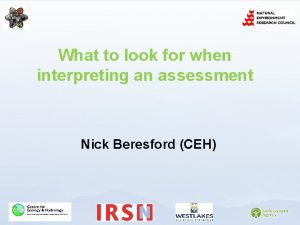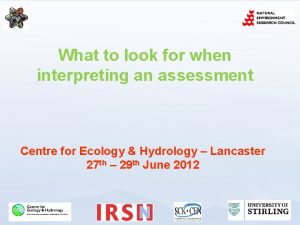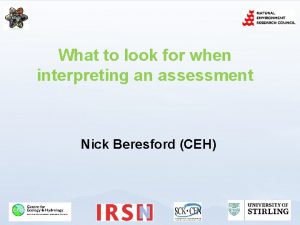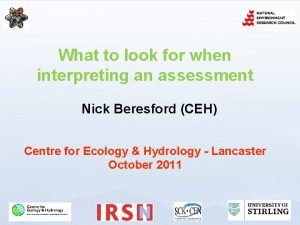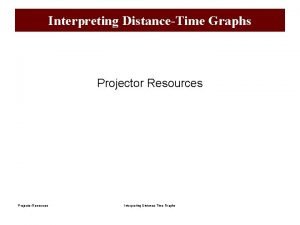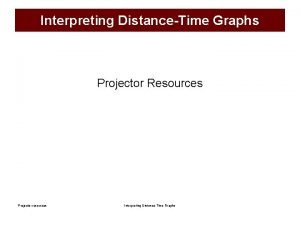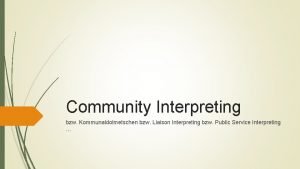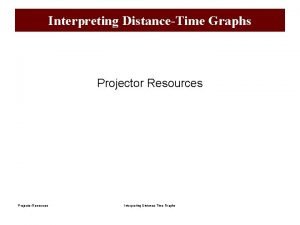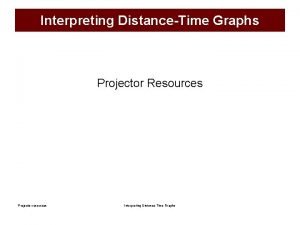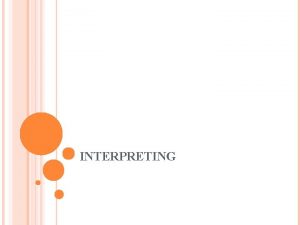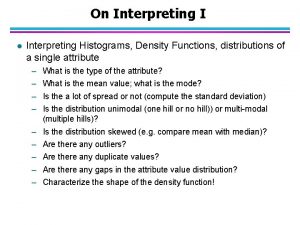What to look for when interpreting an assessment
















- Slides: 16

What to look for when interpreting an assessment Centre for Ecology & Hydrology – Lancaster 1 st – 3 rd April 2014

Objective ¥ Give an overview of what may impact on assessment results using the available approaches In part based on things we know are being done ¥ Consider chronology of development, misuse of default values, double accounting, screening tier application ¥ Not considering dispersion modelling and sampling strategies ¥ www. radioecology-exchange. org

Chronology ¥ Environmental Radiological assessment approaches have developed rapidly over the last 15 y ¥ A number of approaches have been made freely available Some of these have been superseded ¥ But they are still available & are being used ¥ www. radioecology-exchange. org

Chronology ¥ UK ¥ Environment Agency R&D 128 - 2001 Spreadsheet model for limited number of radionuclides ¥ Comparatively limited review to derive CR values ¥ Dosimetry methods similar to later approaches ¥ ¥ Environment Agency Sp 1 a – 2003 ¥ Supports R&D 128 including derivation of complete CR data sets using a ‘guidance approach’ (can be extremely conservative) www. radioecology-exchange. org

Chronology ¥ Europe ¥ FASSET (EC) 2001 -2004 Establish a framework for radiological environmental protection from source characterisation – interpretation, including: ¥ Tabulated CR and DCC values for: ¥ ¥ radionuclides of 20 elements circa 30 reference organism in 7 ecosystems Developed the on-line FASSET Radiation Effects Database www. radioecology-exchange. org

Chronology ¥ Europe ¥ EPIC (EC) 2000 -2003 Establish a framework for radiological environmental protection for the Arctic ¥ Ran concurrent to FASSET and shared CR database ¥ ¥ Although presented differently and for only 12 radionuclides DCCs derived by a different method Allowed participation of Russian institutes leading to EPIC effects database www. radioecology-exchange. org

Chronology ¥ Europe ¥ ERICA (EC) 2004 -2007 Developed the CR and effects (FREDERICA) databases from FASSET & EPIC ¥ Developed FASSET dosimetry methodology ¥ Adapted ‘guidance’ for selecting missing CRs from EA SP 1 a ¥ Output - the ERICA Tool implementing the ERICA Integrated Approach ¥ More generic ecosystem types (because of lack of data) than FASSET and adapted reference organism list (to encapsulate European protect species & remove some unjustified sub-categories) ¥ Derived 10 µGy/h screening dose rate (by SSD) ¥ Being maintained and updated ¥ www. radioecology-exchange. org

d n a Chronology T to E S on S i t ¥ Europe A n F e ) t h s t n ¥ ERICA (EC) 2004 -2007 r i o e band aeffects edatabases t e (FREDERICA) t h e Developed the CR s t t e m – d s d a from FASSET & EPIC e r e e t A t d r a s r a e E o p r Developed FASSET dosimetry methodology ( v e p & o p e p A selecting r u u‘guidance’ s u Adapted missing CRs from EA p ts ICfor s o s d m i A R p T SP 1 a t C ou o E EC ing nd I - tthe ERICA Tool implementing the ERICA n a T ER ICOutput e e approach a O e t integrated n v r P a R o o c i E More d (because t P ecosystem s m generic l types of lack of data) c h a e C / l n reference E Gyand adapted than FASSET organism list (to e o s i t protect i µ encapsulate European species & remove some a d t 0 d da 1 sub-categories) unjustified a g and updated n Being maintained i us ¥ ¥ ¥ www. radioecology-exchange. org

Chronology ¥ International ¥ IAEA (2009 -) Wildlife transfer parameter handbook (in-press) ¥ 2013 - initiate group to draft Volume III of ‘Generic models for use in assessing the impact of discharges of radioactive substances to the environment’ Volume III considers wildlife. ¥ ¥ ICRP Committee 5 (2005 -) Provided tabulated DCC values (using ERICA methodology) and summarised effects information (ICRP-108) ¥ Report presenting CR values for RAPs (ICRP-114) ¥ www. radioecology-exchange. org

Chronology ¥ USA ¥ USDOE Graded Approach (2002) Initially supported by BCG-Calculator spreadsheet model. Still available – but replaced by: ¥ RESRAD-BIOTA ¥ ¥ ¥ Limited and conservative CR values for generic organisms RESRAD-BIOTA v 1. 5 (2009) includes values from the ERICA (original) CR database in supporting documentation for application in uncertainty analysis www. ceh. ac. uk/PROTECT

So don’t. . . ¥ Use out of date approaches unless you can justify why they have been used, e. g. : OK to use R&D 128 for noble gases ¥ Not OK to use FASSET CR values because they offer more ‘refined’ reference organism list/ecosystem range ¥ . . but do be aware that this is an evolving area www. radioecology-exchange. org

Misuse of default values ¥ To serve the purpose for which they were intended RESRAD-BIOTA, R&D 128(SP 1 a) and the ERICA Tool give a complete list of radionuclide-organism transfer parameters. ERICA Tool and R&D 128 missing values derived using ‘guidance’ approaches. These should not be blindly used in higher tier assessments nor should they be picked out for use in other models/recommendations without being clearly identified as such ¥ RESRAD-BIOTA Biv (=CR) values very generic and conservative ¥ www. radioecology-exchange. org

Misuse of default values ¥ ERICA and R&D 128 both clearly identify values which have been derived via guidance approach rather than data ¥ But have been taken as ‘values’ www. radioecology-exchange. org

Double accounting ¥ Some scope for ‘double accounting’ associated with daughter product half-life cut -offs ¥ e. g. R&D 128 includes all 234 Th and 234 U in DCCs for 238 U ¥ ¥ Entering both 234 Th and 238 U activity concentrations would over estimate dose rates RESRAD-BIOTA and ERICA both offer the user the opportunity to do similar www. ceh. ac. uk/PROTECT

t Double accounting o n e r a y / l l e ¥ Some scope for ‘double accounting’ r cia l a a s e r r associated with daughter product half-life cut p u e t s t a e h n g s -offs f u C o a C d s t 234 U in DCCs t D ¥ e. g. R&D 128 includes all Th and n a t e l h u m s for 238 U d w efa s s e n e d d 234 Th and 238 Uliactivity concentrations s a Entering both t n c s i s u a r d n r e would over estimate dose rates e o o d i f d n d t u l a U¥ RESRAD-BIOTA n r c and ERICA both offer the user a t n i r o the opportunity to do similar p im ¥ www. ceh. ac. uk/PROTECT

Summary Do not use/accept out of date approaches – unless justified ¥ Be aware of potential changes as a consequence of recent transfer parameter reviews & forthcoming ERICA update ¥ Ensure no misuse of default values provided by various approaches ¥ ¥ ¥ Use alternatives where justified There are differences between approaches ¥ ¥ ¥ Dosimetric methods tend to give similar results Transfer parameters can add significant variation Screening tiers (see http: //dx. doi. org/10. 1088/09524746/30/2/S 04) www. radioecology-exchange. org
 Look up look down look around
Look up look down look around Activity 1 look up look down
Activity 1 look up look down Activity 1 look at the picture and complete the sentences
Activity 1 look at the picture and complete the sentences Activity 1 look up look down
Activity 1 look up look down Kontinuitetshantering
Kontinuitetshantering Novell typiska drag
Novell typiska drag Tack för att ni lyssnade bild
Tack för att ni lyssnade bild Ekologiskt fotavtryck
Ekologiskt fotavtryck Varför kallas perioden 1918-1939 för mellankrigstiden
Varför kallas perioden 1918-1939 för mellankrigstiden En lathund för arbete med kontinuitetshantering
En lathund för arbete med kontinuitetshantering Kassaregister ideell förening
Kassaregister ideell förening Personlig tidbok för yrkesförare
Personlig tidbok för yrkesförare Anatomi organ reproduksi
Anatomi organ reproduksi Förklara densitet för barn
Förklara densitet för barn Datorkunskap för nybörjare
Datorkunskap för nybörjare Boverket ka
Boverket ka Debattartikel struktur
Debattartikel struktur




















